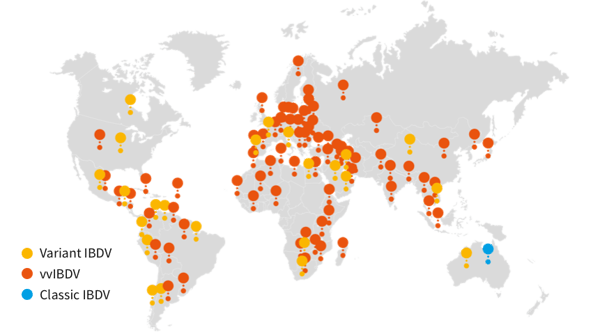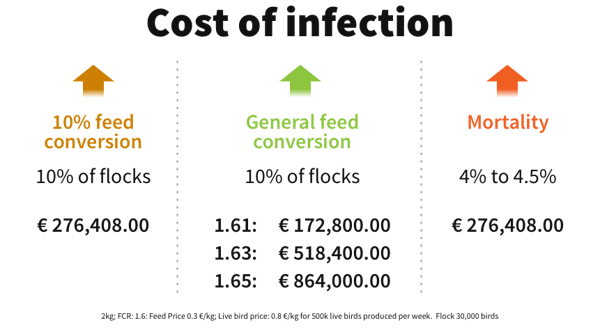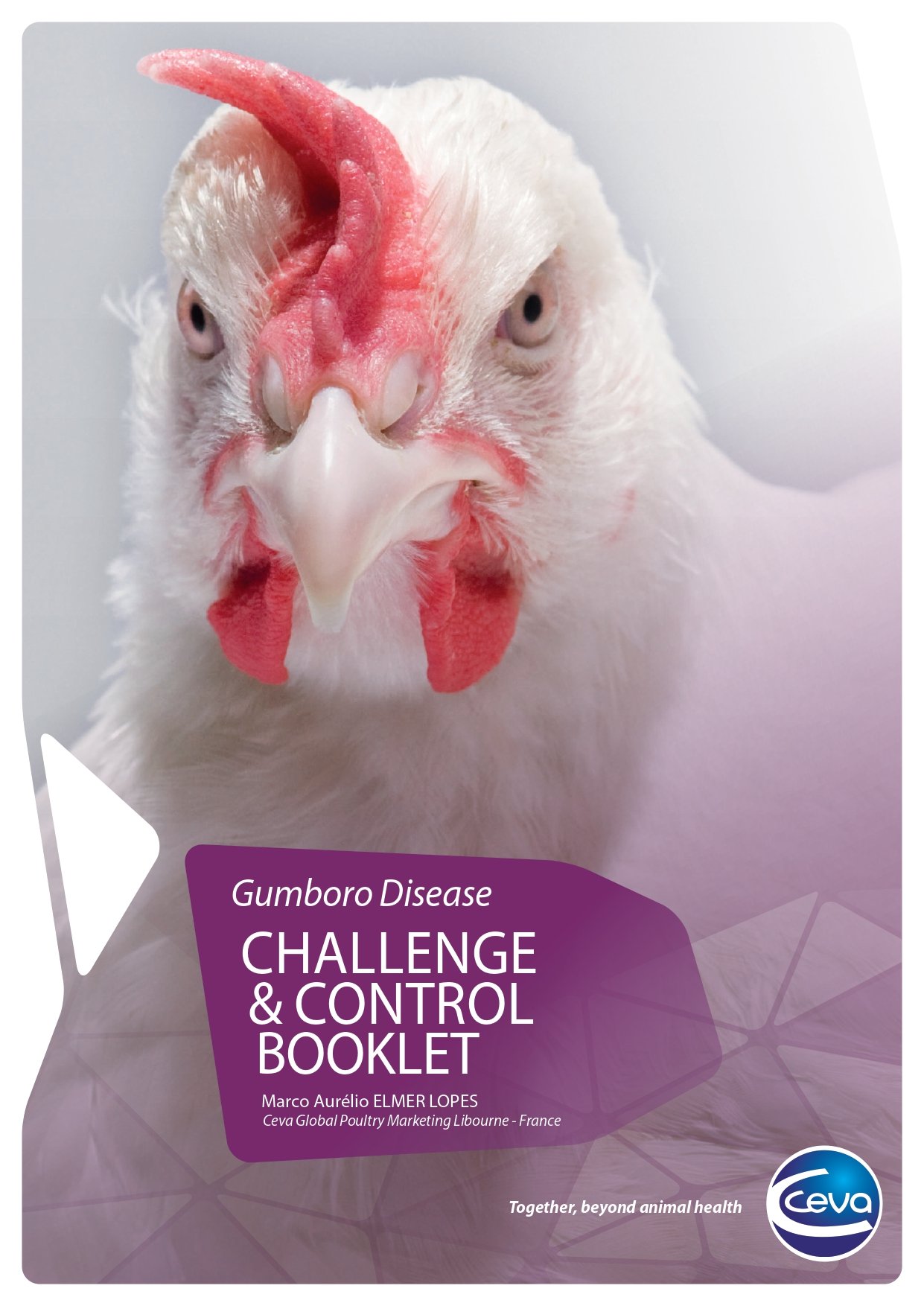Infectious Bursal Disease

Marco Lopes
5 mai 2024
Read it in minutes
Introduction
Gumboro disease, also known as Infectious bursal disease (IBD), is a highly contagious disease of young chickens caused by infectious bursal disease virus (IBDV).
Despite the wide use of vaccines and increased biosecurity, however, it is still very much present and ranks among the top five diseases in almost all countries globally. The World Organization for Animal Health (OIE) listed IBD as a notifiable disease with importance in 2017.
After the initial outbreak in the US, clinical IBD was reported in many other countries. More virulent forms were later reported around the same time that had a very immunosuppressive form of IBD.

Today, the very virulent form is predominant in most countries, and variant strains of IBD are present in several countries, leading to sub-clinical forms of the disease.
The cost of IBD has been very well documented in different publications in the last decade. It has a direct impact on mortality, from 5% to 30%, depending on the degree of protection of the birds and the form of the disease (Rosenberger et al., 1986; Van den Berg, 1991).
In subclinical cases, it can reduce the income per flock by up to 14%, with a 11% reduction in yield and a 10% reduction in profit due to weight loss and increased FCR (McIlroy, 1992).
Recently, interesting calculations have been performed especially focused on the subclinical variant IBD strains. Researchers have identified a positive correlation between serological IBD titers with increased lesions and condemnations during processing.
Spotting Infectious Bursal Disease
IBD is caused by an Avi-birnavirus which replicates and damages the bursa of Fabricius. The Infectious Bursal Disease Symptoms vary, and basically presents 3 different clinical forms: immunosuppressive, clinical and subclinical.
The intensity and extension of the lesions explain the clinical symptoms of infection. Although this is not fully understood, these symptoms depend on several factors including:
- the type of Gumboro virus infecting the chickens,
- the virulence of this virus,
- the genetic type of the chickens,
- their passive and active immunity status,
- the age at infection,
- concomitant infection with other pathogens,
- some environmental factors like the season, the quality of feed, comfort, etc.
All these possible factors of variation associated with the extreme variability of the virus and the often indirect pathogenic process easily explains the variability of the symptoms.
It’s difficult to describe Gumboro Disease in a simple and unequivocal manner. It is however useful to recognise three main theoretical forms of Gumboro Disease
The immunosuppressive form is the consequence of the infection of chickens aged less than 2 weeks by any pathogenic IBD virus. During this time, the organ where B-lymphocytes are produced needs to mature to become functional and provide the chickens with effective humoral immune response capabilities.
The symptoms of immunosuppression varies according to age at infection (the earlier the age, the worse the infection) as well as the type of virus. When compared to more ‘classical’ strains, it has the capacity to create extensive and persistent depletion of the follicles and consequently, dramatically reduce the size of the bursa.
Clinical symptoms may or may not be exhibited by the affected chickens. Post mortem examination generally shows a strong oedema of the bursa with (or without) haemorrhages of variable intensity that can also be seen in the form of petechiae or suffusions in the thighs and breast muscles.
The ‘very virulent’ or ‘hypervirulent’ cases of Gumboro disease reported in several parts of the world where they can still be observed, also show this clinical form. The mortality rate and common symptoms observed varies significantly but is generally higher in slow growing chickens like layer pullets, layer/broiler breeder pullets or organic chickens (generally more than 25%) than in broilers (in general less than 15%).
Other symptoms of the sub-clinical form also can be observed during the processing of the broilers in the slaughterhouse. The increase of condemnations, such as the rejections of livers is reported in some publications.
The sub-clinical form is the most common form of the Gumboro disease currently.
The symptoms observed are:
a) a decrease in flock performance,
b) a slight increase of mortality rate,
c) losses in feed conversion,
d) decrease of weight gain,
e) flock uniformity.
This “sub-clinical” form brings a huge economic impact to the poultry industry, and often goes undetected.
How is IBD Spread?
Since IBD is a very persistent virus, it is capable of prevailing for a long time in the farms.
The Transmission of Infectious Bursal Disease can occur from one bird to another, or from one flock to another. The presence of variant or vvIBDV in previous flocks, can lead to an outbreak if new birds are placed in the same houses.
The Gumboro virus is extremely resistant and it is often unrealistic to imagine eradicating it from a farm. The characteristics of this challenge in chickens (age of birds, severity, consequences, etc.), might vary from house to house, but the challenge will definitely occur at some point in time.
In contrast to other diseases such as NewCastle disease, Infectious Bronchitis or Avian Influenza, which are epizootic diseases (non-resident virus), the Gumboro disease is an enzootic disease, which means that the virus is resident in poultry houses.
Conversely, use of built-up litter management systems increases virus pressure. As there is a higher load of virus, the transmission will increase as well.
However, the strict application of biosecurity measures and thorough cleaning and disinfection will play a critical role in reducing virus pressure and prevent the emergence of new variant viruses. Successful vaccination should protect the chickens and prevent disease challenges.
Control of Infectious Bursal Disease
Gumboro disease, as a resident disease, is already present inside the farm, in the litter, or before the day-old chicks are released onto the floor, so the probability of challenges for most farms is very high.
Vaccination should aim at both protecting the chickens and preventing the challenge from getting out of control, therefore ‘controlling’ the Gumboro Disease.

The objectives of a Gumboro vaccination program must be:
- To ensure continuous protection of the chickens against infection by the Farm IBDV, from delivery of the day-old chicks until departure to the slaughtering plant or laying house (‘viral protection’).
- The chickens should be protected against the clinical consequences of infection (‘clinical protection’).
- To prevent or significantly reduce the amount of virus shed (‘protection against shedding’).
- To prevent the build-up of a higher virus pressure, cycle after cycle
- To stop the evolution of the IBD virus towards a form that could escape the prevention program.
These last two points are the consequences of the ‘protection against shedding’. In other words, the objectives of a sound Gumboro vaccination program should aim to stop the Gumboro cycle.
To achieve the control of the Gumboro disease, the vaccination program should be tailored to the farm and the flock. Several Types of Gumboro Vaccines are available in the market and can be classified into 3 categories:
- Immune Complex vaccines
- Vector HVT-IBD vaccines
- Conventional field vaccines
Other factors that should be observed for optimal short-term and long term control of Gumboro Disease include biosecurity, cleaning & disinfection, and achieving passive immunity.
Biosecurity measures, such as cleaning and disinfection methods are important to suppress the virulent virus and will help to speed up the process of displacement of the field strains to the vaccine strain, in cases where a live IBD vaccine as Immune-complex is used.
Passive Immunity
The most dramatic consequences of Gumboro Disease challenges are observed in cases where the chick is very young. As the vaccine doesn’t take effect for the first two weeks, only passive immunity which is transferred from the breeder to the chick by yolk can be effective at this stage, highlighting its fundamental role and the need to take it into account.
This is why the breeders should also be injected with inactivated IBD vaccines containing IBDV strain, before the laying period, so that the passive protection is transmitted to the progeny.
How Does Gumboro Disease Impact Production
When the subclinical form of Gumboro disease is present, a vaccination failure means the chickens will be infected by the field virus. This may not necessarily cause an immediately perceptible negative effect, but it will create the opportunity for the field virus to multiply, naturally produce variants and spread, with two very important consequences that will impair the future sanitary and/or economical performance of the poultry house or farm:
- The virus pressure (the amount of virus to which the chickens of the next cycle will be exposed) will increase
- An opportunity will be created for a variant virus to colonise the farm. The Gumboro viruses that multiply are then more able to surmount passive protection (from the breeders program) and active protection (from vaccination).
In terms of performance and economical impact, it is well established that Gumboro disease can result in the decrease of weight gain, as well increase the feed conversion, secondary infections, slaughterhouse condemnations, mortality and morbidity, leading to losses and decreased profitability.
Below you will find the economical analysis of the cost of infection in some situations:
- In a situation where 10% of the flocks has the subclinical infection, there will be a 10% decrease in feed conversion;
- Increase of general feed conversion, from 1,60 to 1,61, or to 1,63, or to 1,65.
- Increase of 0,5% of mortality (example from 4% to 4,5%)

Several publications, showed the impact on the performance as described above:
- CANADA (Tata Zachar et al., 2016): Increase of mortality & condemnations;
- EUROPE (Van den Berg et al. 1991): Mortality 25-30% in broilers
- NORTHERN IRELAND (McIlroy 1992): -10% Income in subclinical IBD, when compared with uninfected flocks reduction in weight higher FCR;
- JAPAN (Nunoya et al., 1992): Mortality between 50-60% in layers
As the most common form of Gumboro disease is named “sub-clinical” Gumboro Disease, where the clinical signs are not perceptible, it is important to monitor all the links in the production chain, including the slaughterhouse.
Some publications demonstrate the cost of the sub-clinical form in the slaughterhouse:
- USA (Shane et al., 1994): 10% Rise in production costs
- CANADA (Amini, 2015): Titers for Variant-E strains correlated with increased hepatic lesions and condemnations in the slaughterhouse
- CANADA (Kurukulsuriya, 2016): 1,6 higher risk to develop E. coli septicemia in case of an existing subclinical IBD infection
Conclusion
In conclusion, the Gumboro disease can have several different faces depending on the form (immunosuppressive, clinical or subclinical), but in all cases it will impact the performance, and the profits of the poultry producer.
As a resident disease, it needs to be controlled through vaccination. Hence, a very successful vaccination program against Gumboro disease, whether clinical or subclinical, should not only ensure the ‘protection’ of the chickens against clinical signs following infection, but should also ensure the ‘prevention’ of the disease by decreasing the population of Gumboro virus shed – so that the virus pressure in the poultry house does not increase – and will significantly reduce the risk of emergence of a variant virus. ‘Protection’ and ‘Prevention’ are the two objectives assigned to a Gumboro vaccination program aiming for true ‘Control’ of the disease. This should be undertaken as part of a long-term action plan.
GUMBORO DISEASE
CHALLENGE & CONTROL BOOKLET
Read our GUMBORO CHALLENGE and CONTROL BOOKLET to gain insight into the benefits of a proper vaccination programme to protect your flocks and your profitability.

